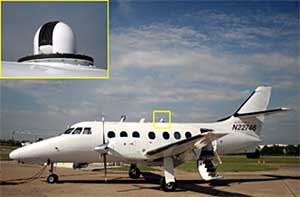Aircraft Comes ALIVE During Field Campaign at the Southern Great Plains
Published: 30 September 2005

Researchers from ARM Program and National Aeronautical and Space Administration (NASA) took to the skies in September for an 11-day Aerosol Lidar Validation Experiment (ALIVE) at the ARM Southern Great Plains (SGP) site. The ALIVE field campaign was conducted to collect airborne remote sensing data on atmospheric aerosols for validation studies of the Raman lidar and micropulse lidars at the SGP site. Measurements from the SGP Raman lidar and micropulse lidars will be validated through comparison with data from the NASA Ames Airborne Tracking 14-Channel Sunphotometer (AATS-14) flown aboard a Jetstream-31 research aircraft from Sky Research. These validations are important to the ARM Program because by calibrating all measurements to consistent standards, the data can help reduce scientific uncertainties in computer models used to simulate climate change.
In 2003, the Aerosol Intensive Operational Period (IOP) at the SGP provided one of the best measurement sets obtained to date for evaluating the scientific capability for measuring the vertical profile of ambient aerosol extinction in the lower troposphere. However, validation results showed that an undetected loss of sensitivity of the SGP Raman lidar had occurred leading up to the Aerosol IOP, resulting in a significant high bias in derived aerosol extinction. To fix this problem, major upgrades were made to the Raman lidar in 2004 to restore and improve its data-gathering capabilities and sensitivity. To prove the integrity of the entire Raman lidar aerosol extinction record, researchers will test the upgraded Raman lidar against data obtained by the AATS-14 and compare its measurements with validated data from the Aerosol IOP.
During the course of 20 flight hours aboard the Jetstream-31, the AATS-14 obtained extinction vertical profiles at altitudes between 500-23,000 ft from spiral ascents and descents over the SGP site. A Scanning Polarimeter instrument from NASA’s Goddard Institute for Space Studies Research also operated aboard the Jetstream-31 as a piggyback instrument, contributing an additional 3-flight hours to the ALIVE field campaign and will provide multi-spectral measurements of the upwelling polarization and radiance. ALIVE also coordinated flights with the new ARM in situ aerosol profile aircraft, a Cessna Turbo 206, to help evaluate the new installation of the instruments that collect in situ aerosol profile measurements.
The ARM Climate Research Facility is a DOE Office of Science user facility. The ARM Facility is operated by nine DOE national laboratories, including .
Keep up with the Atmospheric Observer
Updates on ARM news, events, and opportunities delivered to your inbox
ARM User Profile
ARM welcomes users from all institutions and nations. A free ARM user account is needed to access ARM data.


















